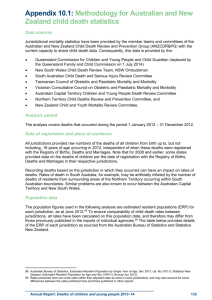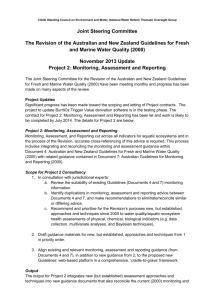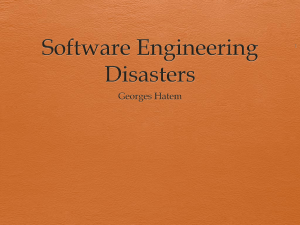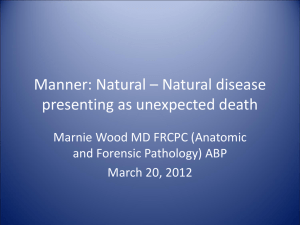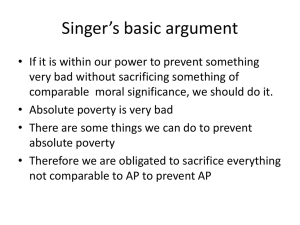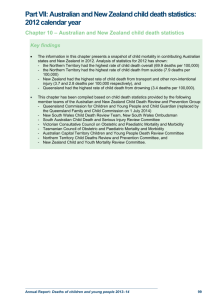Appendix 10.1 - Queensland Family and Child Commission
advertisement
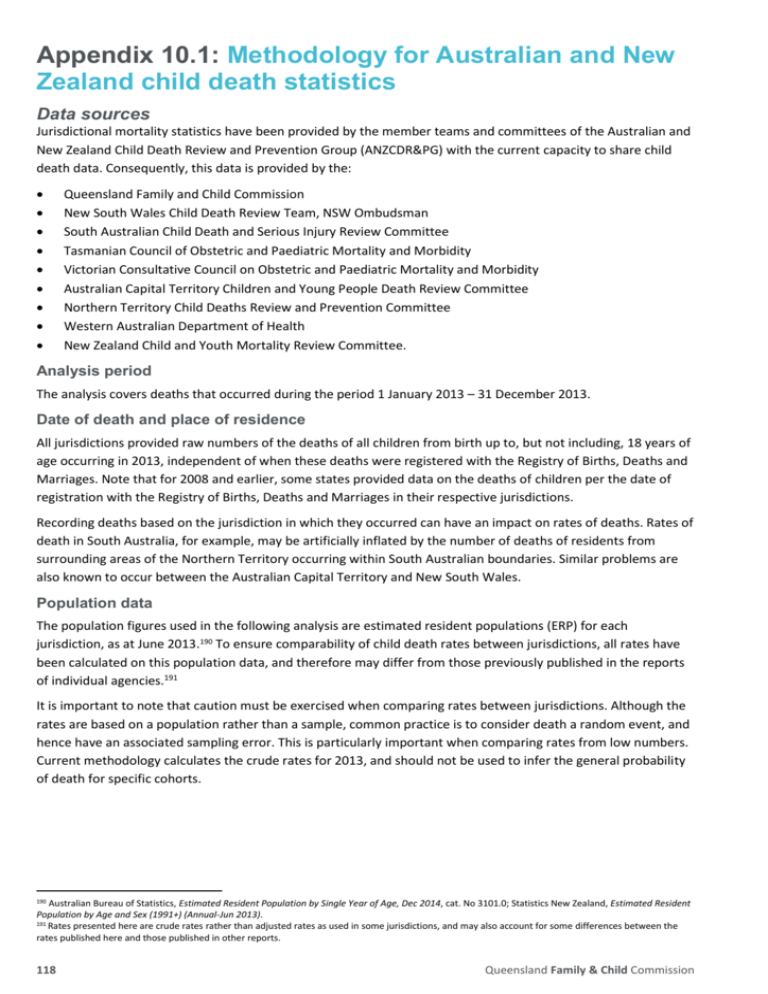
Appendix 10.1: Methodology for Australian and New Zealand child death statistics Data sources Jurisdictional mortality statistics have been provided by the member teams and committees of the Australian and New Zealand Child Death Review and Prevention Group (ANZCDR&PG) with the current capacity to share child death data. Consequently, this data is provided by the: Queensland Family and Child Commission New South Wales Child Death Review Team, NSW Ombudsman South Australian Child Death and Serious Injury Review Committee Tasmanian Council of Obstetric and Paediatric Mortality and Morbidity Victorian Consultative Council on Obstetric and Paediatric Mortality and Morbidity Australian Capital Territory Children and Young People Death Review Committee Northern Territory Child Deaths Review and Prevention Committee Western Australian Department of Health New Zealand Child and Youth Mortality Review Committee. Analysis period The analysis covers deaths that occurred during the period 1 January 2013 – 31 December 2013. Date of death and place of residence All jurisdictions provided raw numbers of the deaths of all children from birth up to, but not including, 18 years of age occurring in 2013, independent of when these deaths were registered with the Registry of Births, Deaths and Marriages. Note that for 2008 and earlier, some states provided data on the deaths of children per the date of registration with the Registry of Births, Deaths and Marriages in their respective jurisdictions. Recording deaths based on the jurisdiction in which they occurred can have an impact on rates of deaths. Rates of death in South Australia, for example, may be artificially inflated by the number of deaths of residents from surrounding areas of the Northern Territory occurring within South Australian boundaries. Similar problems are also known to occur between the Australian Capital Territory and New South Wales. Population data The population figures used in the following analysis are estimated resident populations (ERP) for each jurisdiction, as at June 2013.190 To ensure comparability of child death rates between jurisdictions, all rates have been calculated on this population data, and therefore may differ from those previously published in the reports of individual agencies.191 It is important to note that caution must be exercised when comparing rates between jurisdictions. Although the rates are based on a population rather than a sample, common practice is to consider death a random event, and hence have an associated sampling error. This is particularly important when comparing rates from low numbers. Current methodology calculates the crude rates for 2013, and should not be used to infer the general probability of death for specific cohorts. 190 Australian Bureau of Statistics, Estimated Resident Population by Single Year of Age, Dec 2014, cat. No 3101.0; Statistics New Zealand, Estimated Resident Population by Age and Sex (1991+) (Annual-Jun 2013). 191 Rates presented here are crude rates rather than adjusted rates as used in some jurisdictions, and may also account for some differences between the rates published here and those published in other reports. 118 Queensland Family & Child Commission The table below provides details of the ERP of each jurisdiction as sourced from the ABS and Statistics New Zealand. Estimated resident population by age category and jurisdiction, June 2013 Age category Jurisdiction Under 1 10–14 1–4 years 5–9 years year years Total (0–17 years) 15–17 years Queensland 63,724 252,343 309,676 298,204 182,503 1,106,450 New South Wales 99,341 387,341 464,418 446,821 273,127 1,671,048 South Australia 20,405 79,891 97,866 97,339 61,390 356,891 Victoria 76,450 292,608 349,339 332,863 206,891 1,258,151 Tasmania 6,118 25,322 31,623 32,071 20,105 115,239 Northern Territory 3,993 15,099 17,859 17,064 9,738 63,753 Western Australia 34,572 133,719 160,967 152,848 94,157 576,263 5,508 20,585 23,102 21,278 13,100 83,573 60,260 251,670 300,070 296,790 186,420 1,095,210 Australian Capital Territory New Zealand Data source: Australian Bureau of Statistics; Statistics New Zealand Estimates for the Australian Aboriginal and Torres Strait Islander child population are based on experimental estimates for 2008–2013.192 Estimates for the New Zealand Māori population are based on ERP and were available by single year of age.193 The below table provides details of estimates of the Indigenous child population in each jurisdiction as used in the calculation of death rates in the following analysis. Estimated Indigenous population aged 0–17 years by jurisdiction, June 2013 Jurisdiction Estimated Indigenous population Queensland New South Wales South Australia Victoria Tasmania Northern Territory Western Australia Australian Capital Territory New Zealand 85,673 91,079 15,814 20,547 10,500 26,683 36,873 2,396 275,520 Data source: Australian Bureau of Statistics; Statistics New Zealand Data extraction and methodological differences To assist with comparative research regarding the prevention of child deaths, the ANZCDR&PG has agreed to report under a number of research categories based on the circumstances of death. These research categories capture diseases and morbid conditions and the major external causes of death: transport, drowning, suicide, other non-intentional injury, and fatal assault and neglect. However, it is important to recognise that the deaths counted under each category are as per that particular agency’s classification. In many cases, agencies have multiple sources of information available concerning children (including health, welfare and education records) and are not limited to the causes of death recorded in postmortem reports or death certificates. Accordingly, a team or committee’s classification for a particular death may vary from the World Health Organisation’s International Classification of Diseases (version 10-AM) classifications. 192 Australian Bureau of Statistics, Estimates and projections, Aboriginal and Torres Strait Islander Australians, 2001 to 2026, cat. no. 3238.0. New Zealand, Total Māori estimated resident population, by single-year of age, five-year age group, broad age group, and median age, 1991– 2014. 193 Statistics Annual Report: Deaths of children and young people, Queensland, 2014–15 119 Notable differences include: the Victorian Consultative Council on Obstetric and Paediatric Mortality and Morbidity (CCOPMM) apply coding of neonatal (0–27 days) deaths according to PSANZ-PDC194 and PSANZ-NDC195 rather than ICD-10. However, Victorian data provided by the council for this report has been recoded into the ICD-10 Victorian figures exclude neonatal deaths as a result of terminations of pregnancy (for congenital anomaly or other maternal reason) and those born less than 20 weeks gestation, or, if the gestation is unknown, less than 400 grams birth weight South Australian figures do not include deaths of infants who were born spontaneously before 20 weeks gestation, or deaths of infants as a result of planned termination of pregnancy, irrespective of whether they showed signs of life after birth and irrespective of whether they were registered at Births, Deaths and Marriages as a live birth the methodology for classification of external cause deaths by the South Australian Child Death and Serious Injury Review Committee is available in the Committee’s Annual report at www.cdsirc.sa.gov.au, including a revision of the classification of fatal assault. A number of additional issues affecting data for particular jurisdictions should also be noted: The Victorian CCOPMM notes that the data provided is provisional only. Final data will be available in the yet-to-be-published Annual Report for the year 2013. This will be available from www.health.vic.gov.au/ccopmm/index.htm. The Victorian CCOPMM does not specify raw figures where these are less than, or equal to, five. These are represented by the figure ≤5 throughout the analysis. Australian Capital Territory data does not include deaths of children and young people awaiting the Coroner’s findings. The South Australian Child Death and Serious Injury Review Committee does not specify raw figures where these are less than four. These are represented by the figure <4 throughout the analysis. The New Zealand Child and Youth Mortality Committee notes that: data are from the NZ Mortality Review Database, which collects and stores data for the Child and Youth, and Perinatal and Maternal Mortality Review Committees data consists of deaths occurring in the age range of 20 weeks gestation (or birth weight 400 grams) up to but not including the 18th birthday, and excludes stillbirths and terminations only deaths of New Zealand residents are included in these analyses (overseas deaths are excluded) raw numbers are not specified when they are less than three infant mortality is usually calculated using live births in New Zealand, so presented figures will differ from official New Zealand statistics deaths are recorded as a suicide only when they have been found to be so after the process of coronial review. 194 Perinatal Society of Australia and New Zealand—Perinatal Death Classification. 195 Perinatal Society of Australia and New Zealand—Neonatal Death Classification. 120 Queensland Family & Child Commission
